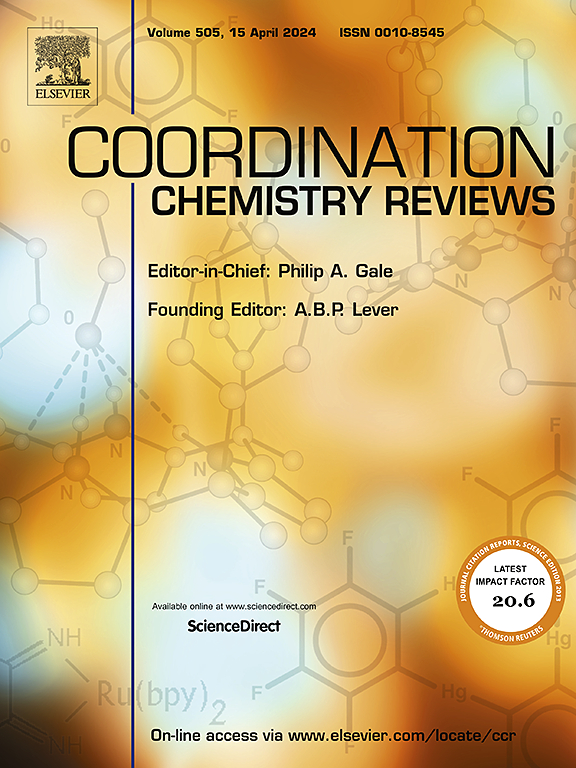Design and engineering of MOF/LDH hybrid nanocomposites and LDHs derived from MOF templates for electrochemical energy conversion/storage and environmental remediation: Mechanism and future perspectives
IF 20.3
1区 化学
Q1 CHEMISTRY, INORGANIC & NUCLEAR
引用次数: 0
Abstract
The ongoing search for sustainable and renewable energy solutions to combat energy shortages and mitigate environmental pollution remains an urgent priority. It catalyzes the rapid evolution of cutting-edge technologies for energy storage and environmental remediation, hinging on advanced functional materials. In addition to the unprecedentedly high surface area and tunable porous structures of metal-organic frameworks (MOFs), its well-organized frameworks make them ideal templates for designing layered double hydroxides (LDHs) and their hybrids. MOF-derived LDHs boasts improved conductivity, stability, and structural adjustability. While MOF/LDH hybrids expose more active sites, leading to augmented catalytic activity and adsorption performance. Hence, this review provides a deep dive into the prospects of MOF-derived LDHs and MOF/LDH hybrids as materials for green energy production, storage, and environmental applications. The structure-property relationship, synthetic mechanism and procedure for the MOF-templated LDH and MOF/LDH composites are thoroughly reviewed. The fundamentals, reaction mechanism and active sites involved for electrochemical energy production and storage are discussed. A comprehensive review is then conducted on the recent advances in utilizing these materials for energy storage and conversion (batteries, supercapacitors, electrocatalysts), as well as environmental applications. Finally, it highlights the advantages, challenges, and future directions in designing MOF/LDH hybrids and LDHs derived from MOF templates. This review serves as a roadmap on utilizing MOFs as templates/components to synthesize advanced functional materials for the future of energy security and environmental salvation.
用于电化学能量转换/存储和环境修复的 MOF/LDH 混合纳米复合材料和 MOF 模板衍生的 LDH 的设计与工程:机理与未来展望
当务之急是不断寻求可持续和可再生能源解决方案,以应对能源短缺和减轻环境污染。这推动了以先进功能材料为基础的能源储存和环境修复尖端技术的快速发展。除了金属有机框架(MOFs)前所未有的高表面积和可调多孔结构外,其良好的组织框架使其成为设计层状双氢氧化物(LDHs)及其混合物的理想模板。MOF 衍生的层状双氢氧化物具有更好的导电性、稳定性和结构可调性。而 MOF/LDH 混合物则暴露了更多的活性位点,从而提高了催化活性和吸附性能。因此,本综述深入探讨了 MOF 衍生的 LDHs 和 MOF/LDH 杂化物作为绿色能源生产、储存和环境应用材料的前景。本综述深入探讨了 MOF 引发的 LDH 和 MOF/LDH 复合材料的结构-性能关系、合成机理和过程。讨论了电化学能源生产和储存的基本原理、反应机制和活性位点。然后全面回顾了利用这些材料进行能量存储和转换(电池、超级电容器、电催化剂)以及环境应用的最新进展。最后,它强调了设计 MOF/LDH 混合体和从 MOF 模板衍生的 LDH 的优势、挑战和未来方向。这篇综述为利用 MOFs 作为模板/组分合成先进功能材料提供了路线图,有助于未来的能源安全和环境拯救。
本文章由计算机程序翻译,如有差异,请以英文原文为准。
求助全文
约1分钟内获得全文
求助全文
来源期刊

Coordination Chemistry Reviews
化学-无机化学与核化学
CiteScore
34.30
自引率
5.30%
发文量
457
审稿时长
54 days
期刊介绍:
Coordination Chemistry Reviews offers rapid publication of review articles on current and significant topics in coordination chemistry, encompassing organometallic, supramolecular, theoretical, and bioinorganic chemistry. It also covers catalysis, materials chemistry, and metal-organic frameworks from a coordination chemistry perspective. Reviews summarize recent developments or discuss specific techniques, welcoming contributions from both established and emerging researchers.
The journal releases special issues on timely subjects, including those featuring contributions from specific regions or conferences. Occasional full-length book articles are also featured. Additionally, special volumes cover annual reviews of main group chemistry, transition metal group chemistry, and organometallic chemistry. These comprehensive reviews are vital resources for those engaged in coordination chemistry, further establishing Coordination Chemistry Reviews as a hub for insightful surveys in inorganic and physical inorganic chemistry.
 求助内容:
求助内容: 应助结果提醒方式:
应助结果提醒方式:


